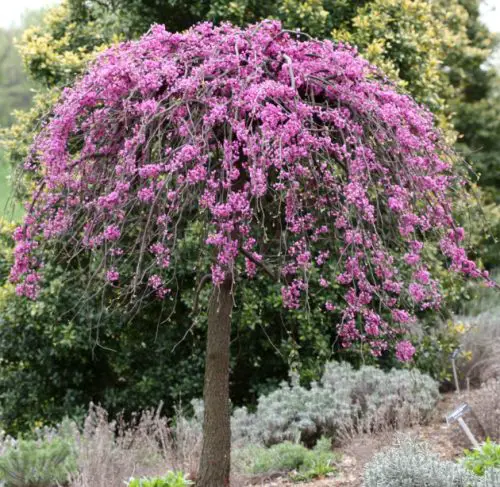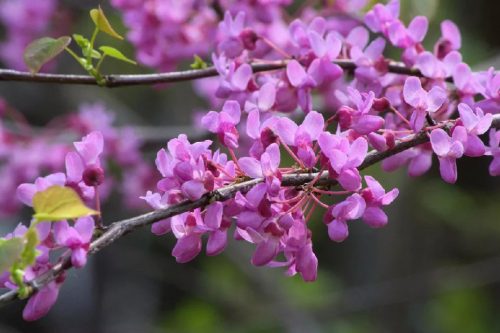In the southeastern expanse of the United States, the announcement of spring comes in the form of delicate, small purple-rose flowers adorning the redbud trees. Native to North America, specifically ranging from parts of Canada down into the northern regions of Mexico, the eastern redbud (Cercis canadensis) graces the landscape with its vibrant presence. While it can be found throughout this expansive region, it has become particularly beloved in the southeastern U.S., where it thrives.
As these redbuds have gained popularity, they’ve become sought-after ornamental trees for home landscapes. The diligent work of plant breeders has given rise to a variety of unique introductions, each adding its own flair to this already cherished species. In this article, our focus turns to the weeping tree variety of the eastern redbud, aptly named ‘Lavender Twist.’ Join us as we delve into the world of this enchanting cultivar, offering insights and tips on how to cultivate and nurture the beauty of Lavender Twist redbuds in your own garden.
Lavender Twist Redbuds Overview

The Lavender Twist Redbud, also known as the ‘Covey’ eastern redbud, traces its origins to a private garden in Westfield, N.Y., discovered by Connie Covey in 1991. After cuttings were taken for propagation by horticulturists, the plant earned its patent in 1998. This dwarf variety, reaching a gradual height and width of 5 to 15 feet (1.5–5 m), boasts distinctive features, including a pendulous, weeping habit and a contorted trunk and branches.
Similar to the common eastern redbud, Lavender Twist redbud trees bloom with small, pea-like pink-purple flowers in the early spring, preceding the emergence of leaves. These blossoms adorn the tree’s cascading, twisted branches and trunk, creating an enchanting spectacle that lasts for about three to four weeks. Following the bloom period, the plant develops bright green heart-shaped foliage. Come autumn, this foliage transitions to a vibrant yellow hue, shedding earlier than many other trees.
One notable characteristic of the Lavender Twist Redbud is its tendency to go dormant earlier than other varieties, contributing to its reputation for enhanced cold hardiness. The contorted branches and trunk, persisting through winter, further add visual interest to the garden during the colder months. Lavender Twist Redbuds stand out as a captivating and unique addition to landscapes, offering year-round appeal with their weeping form, vibrant blooms, and distinctive winter silhouette.
The Allure of Lavender Twist Redbuds

Most admirers of redbuds are immediately captivated by the blossoms, and in the case of Lavender Twist Redbud, the branches are a spectacle adorned with vibrant, rosy lavender blooms.
The appeal of Lavender Twist Redbud extends beyond its blossoms. For those considering a weeping tree, understanding its eventual height and width is crucial. ‘Covey’ stands out as a true dwarf, attaining a modest height of about six feet and a width of approximately eight feet.
As spring progresses and the blossoms gracefully fade away, the tree unveils its attractive leaves characterized by a medium green, glossy texture and a distinctive heart shape. Transitioning into fall, the foliage undergoes a remarkable transformation, showcasing shades of copper, yellow, and gold.
In essence, Lavender Twist Redbud provides visual interest across three seasons. Yet, its allure persists into the winter months as well. The zig-zagging branches, fascinating in their own right, take on a new charm when blanketed in a layer of snow, showcasing the tree’s enduring beauty even amidst the serene winter landscape. Lavender Twist Redbud truly stands as an exceptional plant, offering a delightful display of colors and forms throughout the changing seasons.
Growing and Caring for Lavender Twist Redbuds
Lavender Twist Redbuds exhibit hardiness in U.S. zones 5 through 9, thriving in conditions that strike a balance between moisture and well-draining soil, ideally under full sun to partial shade. In regions with warmer climates, providing some shade during the afternoon sun proves beneficial. Come spring, nourish these trees with a general-purpose fertilizer before the delightful blooms emerge.
Although this cultivar isn’t as resistant to drought as some others are, it is still fairly resilient. When the top three inches or so of soil start to dry up, offer some water.
During the growing season, treat your tree once a month using an all-purpose, balanced fertilizer. It’s ideal to use something similar to Triple 10 All Purpose Liquid, which has a 10-10-10 NPK.
Lavender Twist Redbuds are hardy plants that may survive adverse circumstances, such as encountering deer. These trees are not only lovely, but they also attract pollinators such as bees, butterflies, and hummingbirds, increasing the biodiversity of the garden.
For those who prefer a tailored appearance, Lavender Twist Redbuds can be pruned while dormant, allowing for shaping to meet specific aesthetic preferences. If the aim is a straight trunk and a taller tree, young weeping Lavender Twist Redbuds can be staked. Alternatively, if left to grow organically, the trunk takes on a captivating contorted form, resulting in a shorter tree.
It’s important to note that once established, Lavender Twist Redbud trees may not transplant well, underscoring the significance of choosing the planting site thoughtfully. By selecting an ideal location, this splendid specimen tree can flourish and grace the landscape with its unique beauty for many years to come.
Grow Lavender Twist Redbuds in Containers
Due to its compact stature, Lavender Twist Redbud proves to be an excellent contender for container gardening.
When selecting a container for your Lavender Twist Redbuds, opt for one that is at least two sizes larger than the nursery pot it comes in. It’s advisable to choose a pot that errs on the side of being slightly larger, as the additional soil not only accommodates root growth but also provides insulation during the winter months.
Consider the material of the pot carefully. Terra cotta, susceptible to cracking in winter, and metal, prone to temperature extremes, may not be the most suitable choices. Instead, opt for containers made of fiberglass, wood, concrete, or insulated plastic, which generally offer optimal conditions for container growth.
Contrary to common practice, refrain from placing a layer of rocks at the bottom of the container. Instead, fill it entirely with quality potting soil, ensuring to plant your Lavender Twist Redbud at the same depth as it was originally in the nursery pot.
Maintaining a container-grown Redbud parallels the care provided when planted in the ground. However, during extended cold snaps or cycles of freezing and thawing, it’s prudent to wrap the container in burlap or another form of insulation for added protection. Additionally, a thick layer of mulch placed atop the soil serves as an effective measure to safeguard against temperature fluctuations and ensures the well-being of your containerized Lavender Twist Redbuds.
Pest and Disease Management for Lavender Twist Redbuds
Lavender Twist Redbud shares susceptibility to common pests and diseases that may affect other varieties of redbuds.
Vigilance is key, particularly in monitoring for leaf rollers (Fascista cercerisella) and emerald ash borers (Agrilus planipennis). Additionally, be attentive to the potential development of canker (caused by Botryosphaeria spp.) and verticillium wilt (caused by Verticillium albo-atrum).
Regular observation and prompt intervention are recommended to address any signs of pests or diseases promptly. Implementing good gardening practices, such as proper watering, soil management, and providing adequate spacing between plants, can contribute to the overall health and resilience of Lavender Twist Redbud in the face of potential pest and disease challenges.
In conclusion, with thoughtful care and attention, Lavender Twist Redbud trees will continue to grace your garden with their unique charm and enduring allure for years to come.
People Who Read This Also Read:






